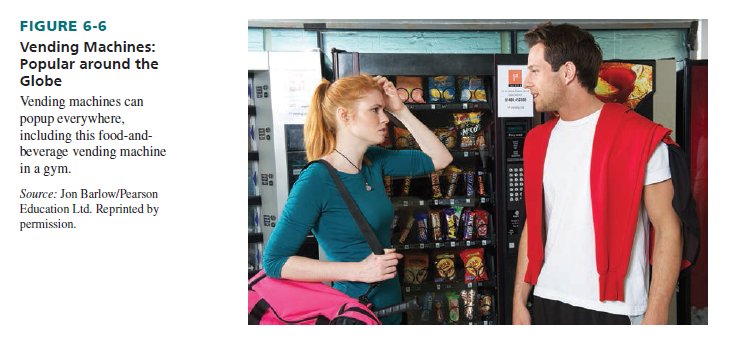A vending machine is a cash- or card-operated retailing format that dispenses goods (such as beverages) and services (such as electronic arcade games). It eliminates use of sales personnel and allows 24-hour sales. Machines can be placed wherever convenient for consumers—inside or outside stores, in motel corridors, at train stations, or on street corners. See Figure 6-6.
Although there have been many attempts to “vend” clothing, magazines, and other general merchandise, the vast majority of the $65 billion in annual U.S. vending machine sales involve cold beverages, candy, snacks, and confections. The greatest sales at are public places such as service stations and at offices; colleges, universities, and elementary schools; factories; and hospitals and nursing homes.13 Newspapers on street corners and sidewalks, various machines in hotels and motels, and candy machines in restaurants and at train stations are visible aspects of vending but account for a small percentage of U.S. vending machine sales. Leading vending machine operators are Aramark Corporation and Canteen.
Items priced above $1.50 have not sold well; too many coins are required, and some vending machines do not have dollar bill changers. Consumers are reluctant to buy more expensive items that they cannot see displayed or have explained. However, their expanded access to and use of debit cards are having an impact on resolving the payment issue, and the video-kiosk type of vending machine lets people see product displays and get detailed information (and then place a credit or debit card order). Popular brands and standardized nonfood items are best suited to increasing sales via vending machines.
To improve productivity and customer relations, vending operators are being innovative. Popular products such as french fries are made fresh in vending machines. Machine malfunctions are reduced by applying electronic mechanisms to cash-handling controls. Microprocessors track consumer preferences, trace malfunctions, and record receipts. Some machines have voice synthesizers that are programmed to say “Thank you, come again” or “Your change is 25 cents.”
Operators must still deal with theft, vandalism, items out of stock, above-average prices, and a perception that vending machines should be used only when a fill-in convenience item is needed.

Major regulatory issues confronting the industry concern cigarette sales and beverages sold at public schools. Prior to age restrictions on cigarettes, cigarette sales at vending machines made up 25 percent of vending machine sales. They now comprise 1 percent of vending machine sales. New regulations imposed starting in the 2014-15 school year by the Healthy, Hunger-Free Kids Act of 2010 limit sodium, sugar, and calories in all snack items sold at school vending machines.
Source: Barry Berman, Joel R Evans, Patrali Chatterjee (2017), Retail Management: A Strategic Approach, Pearson; 13th edition.

Good info. Lucky me I reach on your website by accident, I bookmarked it.